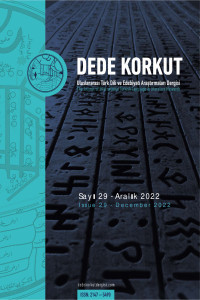AŞKIN DİLİ: OĞUZ LEHÇESİ
Zihin ile dış dünya arasında en önemli aracı dildir. Kullandığımız dil, insan olma eylemini de nasıl gerçekleştirdiğimizi yansıtmaktadır. Bu makalede insan oluşun kaotik bir içleme sahip olduğu savından hareketle, aşk duygusunun bu kaotik yapı ile olan ontolojik ilgisi temellendirilmektedir. Aşk duygusu ifadesini dilde bulmaktadır. Günümüz Türkçesinin temel lehçesi olan Oğuz lehçesinin bu yalın insanî var oluşa tekabül eden ifade ediliş biçimlerinin aşk temalı olduğu tespit edilerek; Türk insanının bireysel özünün aşk kavramında anlamını bulduğu savunulmaktadır
Aşkın Dili: Oğuz Lehçesi
The most important tool between the mind and the outside world is language. The used language reflects that how the action of the human being was performed. In this article as an ontological the chaotic inner world of man with love will be associated. Article claiming that of the Oğuz polish is reflect the ontological basis of love. When analyzed the the most important examples of Oguz dialect, the form of repetitive processing of the theme of love is seen. Accordingly, with concept of love the essence of individuality finds in turkish its own meaning. In use of Turkish by the feeling of love, the meaning and the language universes can be ontologically identified
Keywords:
-,
___
- ATALAY, Besim (2006). Divanü Lügati't – Türk, Ankara: Türk Tarih Kurumu Basımevi, Cilt I.
- BAYAT Fuzuli (2004). “Uz-Ğuz-Oğuz Kavim Adının Etimolojisi”, Karadeniz Araştırmaları, S. 3, s. 71-77.
- BERNSTEİN, J. Richard (2000). “The Challenge of Scientific Materialism”, Davidson, D, Materialism And The Mind-Body Problem, edt, David Rosenthal, Indianapolis: Hackett (200-223).
- CELALEDDİN Rumi (2012). Mesnevi, çev; Tahir Olgun, Şefik Can, İstanbul: Ötüken, c. 1.
- DAVİDSON, D (2000). “Mental Events”, Materialism And The Mind-Body Problem, edt, David Rosenthal, Indianapolis: Hackett (232-249).
- ERGİN Muharrem (2000). Dede Korkut Kitabı, İstanbul: Boğaziçi Yayınları.
- EŞREFOĞLU Rumi (1967). Eşrefoğlu Rumi Divanı, İstanbul: Cağaloğlu Yayınevi.
- FROMM, E (2006). The Art Of Loving, Harper New York: Perennial.
- GADAMER, H.G. (2008). Philosophical, Hermeneutics, Edt, Trns; D.E. Linge, Berkeley: California University Press.
- GLENDİNNİNG, Simon (1999). The Edinburgh Encyclopedia of Continental Philosophy, London: Fitzroy-Dearborn.
- HAYLES K. (1991). Chaos And Order, Complex Dynamics in Literatür and Science, edt, K. Hayles, Chicago: Chicago University Press.
- LOGAN K. Robert (2008). The Extended Mind: The Emergence of Language, The Human Mind And Culture, Toronto: Toronto University Press.
- PALMER R. (1982). Hermeneutics; Interpretation Theory in Schleiermacher, Dilthey, Heidegger, and Gadamer, Illinois: Northwestern University Press.
- PATTERSON S; Crane T. (2000). History of The Mind-Body Problem, New York: Routhledge.
- SARTRE J. P. (1992). Being And Nothingness, Trns; H. E. Barnes, New York: Simon and Schuster.
- TİMURTAŞ Faruk Kadri (1994). Eski Türkiye Türkçesi, İstanbul: Enderun Kitabevi.
- TOPRAK Burhan (2006). Yunus Emre Divanı, İstanbul: Eskişehir Odun Pazarı Belediyesi.
- WITTGENSTEIN L. (2010). Philosophical Investigations, trns; M. Anscombe, S. Hacker, J. Schulte, Oxford: Blackwell. İNTERNET KAYNAKÇASI
- http://ekitap.kulturturizm.gov.tr/Eklenti/10811,oguzkagandestanipdf.pdf?0 (Erişim Tarihi: 03-07-2014)
- http://ekitap.kulturturizm.gov.tr/Eklenti/12031,ahmedyugnekipdf.pdf?0 (Erişim Tarihi: 07-03-2014)
- http://pirsultanabdalsiirleri.blogspot.com.tr/2008/04/ak-ile-yrdk-sen-pire- geldik.html (Erişim Tarihi: 09-07-2014)
- http://www.turkuler.com/nota/siirler.asp?kisi=88 (Erişim Tarihi: 09-07-2014).
- http://www.antoloji.com/guzelligin-on-par-etmez-siiri/ (Erişim Tarihi: 10-07-2014)
- http://karacaoglandansecmeler.wordpress.com/ (Erişim Tarihi: 09-07-2014).
- ISSN: 2147-5490
- Başlangıç: 2012
- Yayıncı: Nuh DOĞAN
Sayıdaki Diğer Makaleler
Taşköprîzade Kemaleddin Mehmed Ve Şerh-İ Ehadis-İ Erbain Adlı Eseri
Yakup POYRAZ, Mustafa Sefa ÇAKIR
Azerbaycan Ve Türkiye Türkçesinde Yabancı Özel Adların Yazımı Meselesi
Yunus Emre Divanında Can Kelimesi Üzerine
KOSOVA TÜRK ÇAĞDAŞ EDEBİYATINDA REŞİT HANADAN’IN ÖYKÜ VE ROMAN YARATICILIĞI
Hindistan’ın Rampur Raza Kütüphanesi’ndeki Edebiyatla İlgili Türkçe El Yazmaları Üzerine Notlar
Türkmen Türkçesinde Görülen Yalancı Eş Değer Kelimeler
Türk Kültüründe “Deliler” Ve Bunların Dede Korkut Oğuznâmelerine Yansıması
18. YÜZYILA AİT BİR RİSALEYE GÖRE MIKNATISIN DİNSEL-BÜYÜSEL VE TIBBİ İŞLEVLERİ
Türkçe–Farsça İlişkileri Türkçenin Farsça Üzerindeki Etkilerine Dair Bir İnceleme
